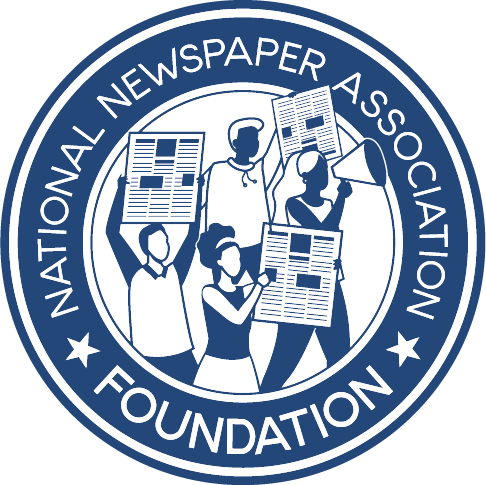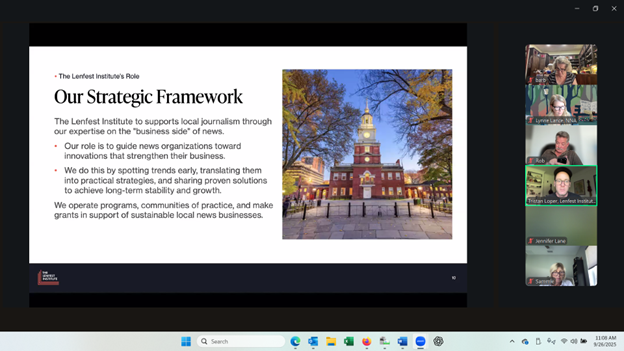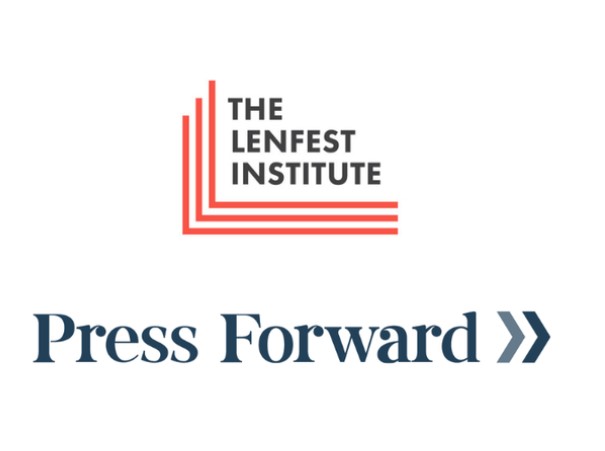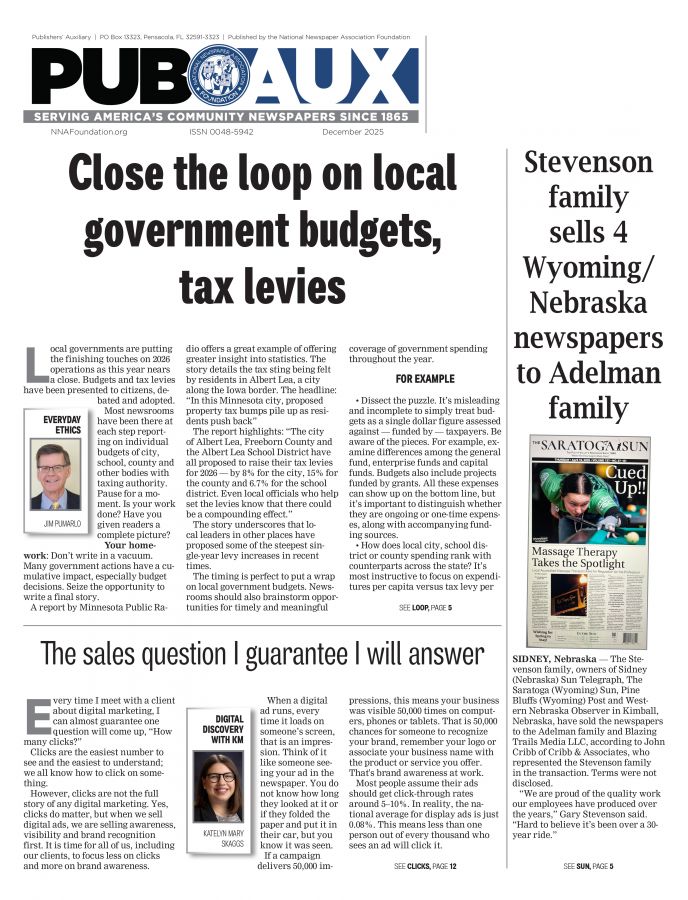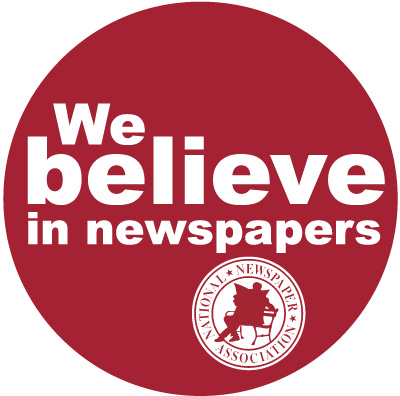Press Forward grants help newspapers keep their presses running and their communities informed
Teri Saylor
Special to Publishers' Auxiliary
Feb 1, 2025
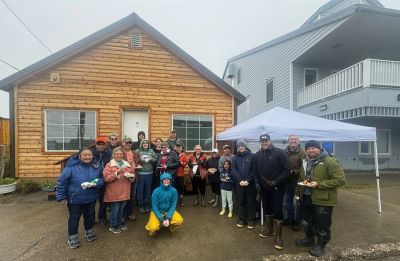
Editor's Note: This is the second in a short series of stories about newspapers that received funding through Press Forward’s first round of grant funding.
Upgrades, enhancements, sustainability and public service are on the minds of the newspaper publishers who received a $100,000 grant from Press Forward, a national movement to strengthen communities by reinvigorating local news.
Diana Haecker, editor of The Nome (Alaska) Nugget, Bob Bonnar, publisher of the News Letter Journal in Newcastle, Wyoming, and Matt Paxton, publisher of The News Gazette in Lexington, Virginia, are deeply passionate about their communities but are struggling with the reality brought on by social media domination and declining revenues. To continue providing quality reporting for their communities and fulfilling their watchdog roles, they say they need to upgrade their operations.
In 2024, Press Forward announced its national initiative to strengthen communities and democracy by supporting local news and information. Formed in 2023 when a coalition of 22 donors injected over $500 million into a five-year funding engine, the initiative will enhance local journalism and re-establish local news as a force for community cohesion, support new models and solutions that are ready to scale, and close long–standing inequities in journalism coverage, the release stated.
Last spring, over 900 news organizations applied for part of the $20 million in grant funding. The 205 recipients each received $100,000 distributed over two years. Among the recipients are online news organizations, nonprofits, advocacy groups and newspapers. Grants reached into nooks and crannies all over the country and funded at least one recipient in every state.
THE NOME (ALASKA) NUGGET
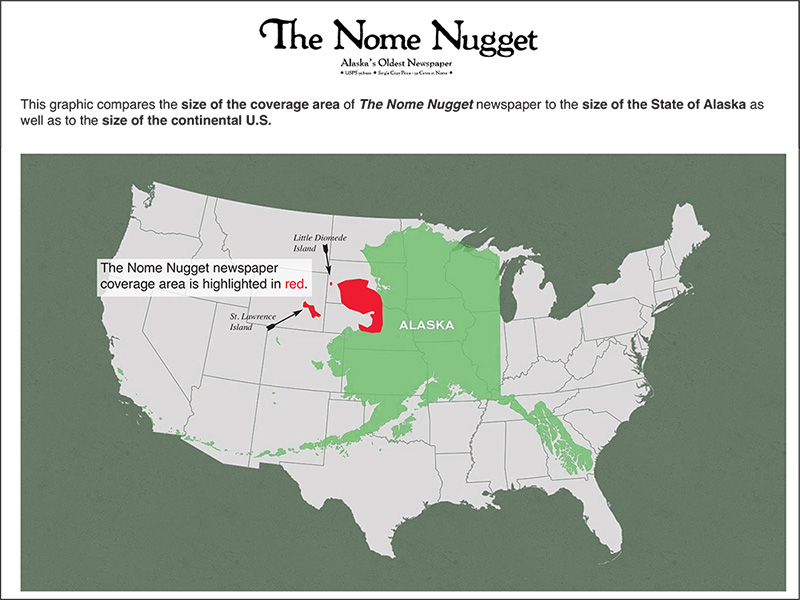
The Nome Nugget covers a vast region, shown in red. If the newspaper vanishes, over 23,000 square miles would become a news desert. (Map courtesy of Diana Haecker)
Late in December, on the shortest days of the year in Nome, Alaska, the sun rises at midday and sets before 4 p.m.
“There’s a long period of twilight on each end of the sunrise and sunset, with about three hours of proper sunlight in between,” said Diana Haecker, editor of The Nome Nugget.
Even on the darkest days of winter, The Nugget takes its watchdog role seriously and makes sure there’s an abundance of sunlight shining on the community every day. And the newspaper has been providing those rays of sunshine for 125 years.
“The Nugget continues to fulfill its role of keeping an eye on government, quasi-government organizations and public safety and police departments,” Haecker said.
And thanks to a recent Press Forward grant, The Nugget will be able to fill that role for years to come.
The Nome Nugget, established in 1900, is known as the oldest newspaper in Alaska. The town of Nome was born out of the 1896 gold rush, when thousands of miners flocked to Alaska to seek their fortunes. Many of them struck it rich in Nome, and by 1898, had decided to stay. The town was incorporated in 1901.
The Nugget is the only newspaper with locally and regionally relevant news for people living in the vast and isolated area of western rural Alaska. Haecker reckons that if The Nugget vanished, a 23,000–square– mile region of rural Alaska would become a vast news desert. Further, the town is not connected to the state’s road system, and the only way in is by air, dog sled or snowmobile.
“We’re pretty insular, and we thought the grant would be a great way to get help from experts to improve our operation and to remain sustainable in the future,” Haecker said.
She plans to use the grant for operational upgrades, business consulting and outreach strategies, including community events. They also plan to experiment with a podcast.
Haecker moved to Nome 22 years ago and started her career with the newspaper as a reporter. She serves as co-publisher with her husband, Nils Hahn, who is involved with the famed Iditarod sled dog race and has run the race four times. The pair purchased The Nugget from the estate of Nancy McGuire who owned, published and edited the paper from 1982 until her death in 2016. The newspaper has six employees, including Haecker and Hahn.
Last August, The Nugget completed a building renovation and held a community cookout to celebrate.
“We bought a bunch of hot dogs and just started grilling in front of our shop and invited people to come,” she said. “It was an awesome event and a great way to connect with our readers.”
Haecker views this type of community outreach as a way of explaining the newspaper’s value, and even though the newspaper speaks for itself, regular readers sometimes take it for granted.
In the summer of 2022, a harmful algal bloom was detected in the Bering Strait region of Alaska, near Nome. The bloom with its potent toxins posed a serious threat to human health and food security for the community.
The Nugget broke the news to its readers and kept them informed and safe.
“We are a region where groceries are extremely expensive because they have to be flown in,” Haecker explained. “We are kind of a subsistence economy, which makes up almost 75% of our food, so if we have a harmful algae bloom that can poison people, it is super important that we provide timely and accurate information.”
Life at The Nugget is hectic on Mondays — deadline day. The team lays out the pages on Tuesday and transmits them to a press in Anchorage, where it is printed on Wednesday morning at 6 a.m. The newspapers are delivered to Alaska Airlines and flown back to Nome, where they are bundled and flown to outlying communities.
In 2023, a fiber optic cable was disrupted, bringing the internet down for four months and severing Nome from the rest of the world. Using a hot–spot connection, The Nugget team managed to transmit the pages to the printer for 16 weeks without missing a single issue.
“It took two hours to transmit the newspaper to the printer, and it was a huge challenge,” she said. “We bent over backwards and nearly killed ourselves, but we delivered, and that brought home to our readers that you might not be able to get your news online when there is no internet, but the newspaper will be on your desk every Thursday.”
Some advertisers and local officials who place public notices in the newspaper began rumbling about the grant funding, suggesting the newspaper no longer needs ad revenue or public notices.
For Haecker, their objections created a teaching moment, and she explained the grant was not to keep the lights on.
“That’s our job, and that’s what we do,” Haecker said. “The grant is to set us up so the lights stay on for the next 100 years.”
NEWS LETTER JOURNAL, NEWCASTLE, WYOMING
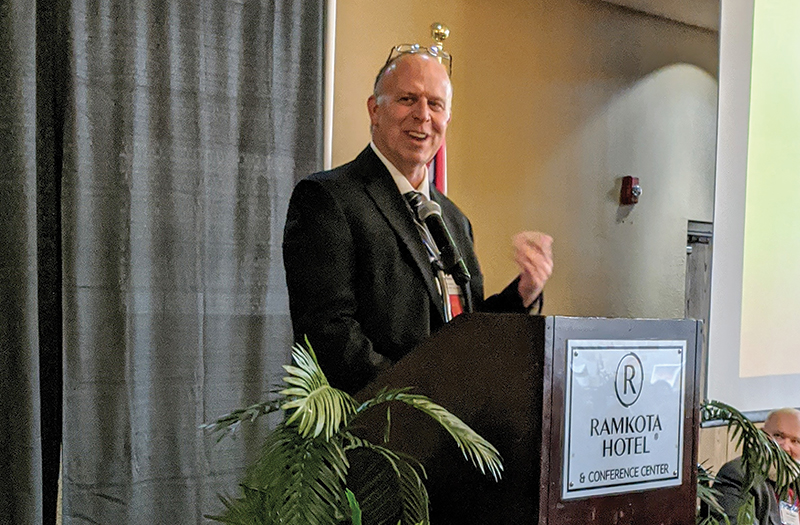
Bob Bonnar, publisher of the News Letter Journal in Newcastle, Wyoming, plans to use Press Forward grant funding to upgrade his equipment, invest in staff training and beef up his media platforms. Photo courtesy of Wyoming Press Association.
Christmas came early last year for Bob Bonnar and the News Letter Journal, a 1,500-circulation weekly newspaper in Newcastle, Wyoming, when he received his $100,000 grant from Press Forward.
At the top of his shopping list is new equipment for the newspaper, staff training initiatives, enhanced video and podcasting capabilities, and building his team.
Bonnar views his grant as a lifeline and a pathway to the future.
“This grant is going give us an opportunity to put some real thought into our organization and what it ultimately needs to produce for us as a business,” Bonnar said. “We've always focused on providing for our community needs, and I'm proud of that, but I didn't know how we were going to be able to continue until we got the grant.”
Bonnar followed his mother into journalism. She was a broadcaster-turned-newspaper editor, and he has fond memories of working with her when he was a teenager. He and his wife, Stephanie, own the News Letter Journal, and they run the newspaper from their home in Durango, Colorado, where they moved just before the COVID-19 pandemic.
Together, news editor Alexis Barker and general manager/managing editor Kim Dean keep things running on site.
The News Letter Reporter is an award-winning newspaper on both state and national levels. Bonner credits those awards for opening doors and helping him forge connections with other publishers and editors along the way.
“I was welcomed right into the club, into the old backrooms with the cigars and whiskey, where I learned so much,” Bonnar said. He went on to become active in the Wyoming Press Association and served as term as president.
Newcastle is a rural community, sitting on the northeastern edge of Wyoming along the border with South Dakota. Its population is around 3,400. According to the Travel Wyoming website, Newcastle was formed after the coal and railroad industries came to the area, along the Cheyenne to Black Hills stagecoach route. The nearby Thunder Basin National Grassland and Black Hills provide a haven for outdoor enthusiasts.
Like many weekly newspapers, the News Letter Reporter considers “refrigerator journalism” as its bread and butter. Bonner’s not shy about publishing hard–hitting journalism.
In 2020, the newspaper’s news team fought to report on the construction of a $740,000 home and station for the Newcastle game warden and his family. Purchased by the Wyoming Game and Fish Department, property costs ran nearly a half-million dollars over budget. Further, the newspaper faced a $300 fee to access public records about the project.
Their efforts won them a first-place FOIA award in NNA’s 2021 Better Newspaper Contest.
The News Letter Reporter comes out in print on Thursdays and delivers news and information on a variety of platforms.
“We are digital and we also run a thriving Facebook page, a weekly email newsletter, a YouTube Channel and a podcast,” Bonnar said.
And for all the highs and lows in the newspaper business, Bonnar is excited about the future and hones strategies to stay a few steps ahead of the competition. Technology helps.
He’s used 20% of his first round of grant funding on equipment upgrades, and he’s investing in training for himself and his staff, particularly on digital media platforms.
“Honestly, I’ve just trained myself using YouTube videos and tutorials, and just jumping in and doing it,” he said.
At the end of the day, Bonnar acknowledges that print is still king. Many of his readers prefer it, and print is the only way he believes newspapers can preserve public notices.
“Moving legal notices exclusively online opens the door to letting government publish them on their websites, and that would be an absolute tragedy,” he said.
Still, ever-rising printing and distribution costs are making print publishing more challenging.
In a news story announcing his grant, Bonnar told his readers that the newspaper hasn’t been able to produce an abundance of additional multimedia revenue, but the funding will give him an opportunity to improve both the products he produces and his staff’s ability to produce them.
“This grant recognizes the importance of having an active press that challenges government and ensures accountability in rural parts of the country,” Bonnar said. “The funding will give us breathing room to fine tune the foundation we have already laid and see how we can build on that.”
The grant is proving to be “life changing” for his newspaper and his community.
“I’m very positive about our future and believe the sky’s the limit,” he said.
THE NEWS-GAZETTE, LEXINGTON, VIRGINIA
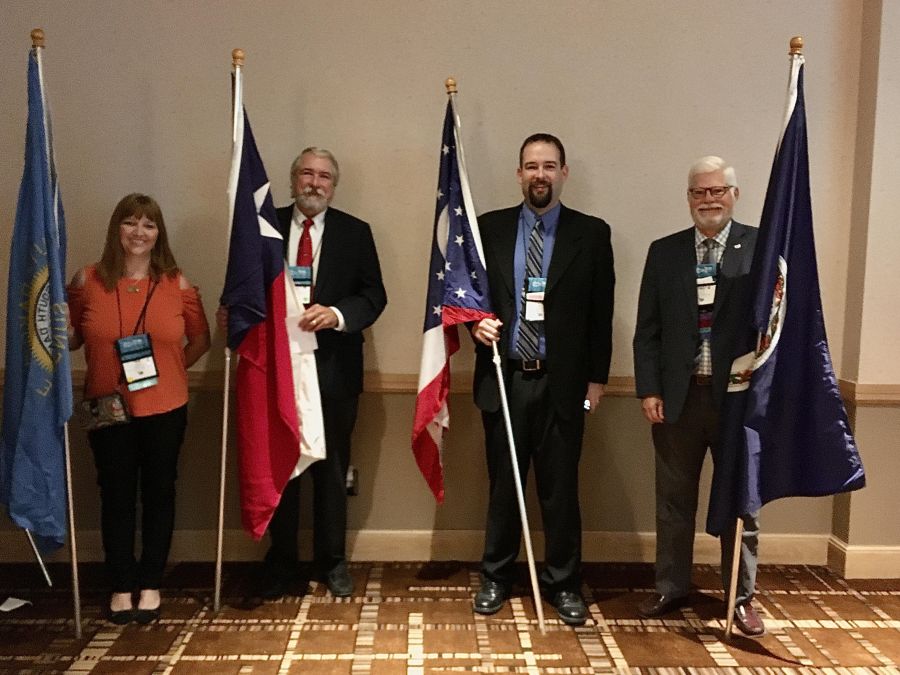
At the Annual Convention & Trade Show in Jacksonville, Florida, Matt Paxton (far right), represents Virginia in a flag ceremony. Photo by Teri Saylor.
The News-Gazette, nestled in the heart of the picturesque Shenandoah Valley in rural Virginia, calls Lexington home.
“The News-Gazette is proud to be part of a bright mosaic of independent, nonpartisan newspapers that are reimagining what local news looks like across America,” said News-Gazette publisher Matt Paxton in an article published last year announcing his grant funded through Press Forward.
“Our peers include newer nonprofits, some launched as information needs became evident during the pandemic,” he said. “Others are enduring commercial newspapers that continue to adapt and innovate after a century, or in the case of The News-Gazette, 223 years in business.”
The News-Gazette, published weekly in Lexington on Wednesdays, is part of a publishing tradition that goes back to 1801. Its other ancestor was the Rockbridge County News, founded in 1884. The two newspapers merged in 1962, forming The News-Gazette, the third oldest newspaper in Virginia, and the oldest in the state west of the Blue Ridge Mountains.
“Our circulation is 5,500 in print with another 250 digital–only subscriptions,” Paxton said.
Paxton descends from a long lineage of publishers and represents the fourth generation of Paxton family members involved in the newspaper. He’s been there for 45 years and views his role as making sure the newsroom has the people and the tools they need to tell the stories that need to be told in the community.
He plans to use his grant to make the newspaper operations more sustainable. The News-Gazette has survived and thrived for over two centuries, and like other newspapers, faces threats from rising costs and the proliferation of low-cost, easily accessible digital information that might not be reliable.
Paxton told his readers that he has been focusing on setting priorities so the newspaper and community get the best use from the grant. Maintaining stability as a locally owned news source and improving online and digital programs rise to the top. The extra money also gives him an opportunity to address the newspaper’s infrastructure.
“We are using some of the money for consulting on digital strategies, and possibly to add staffing in that area,” he said. “And we replaced a leaky roof over our newsroom.”
First settled in 1778, Lexington is best known as the home of the Virginia Military Institute and Washington and Lee University. The town is a mecca for history buffs who flock there to learn about the role Lexington played as a site during the American Revolution and the Civil War. The area is also home to scenic hiking trails and picturesque water trails for paddling and floating. The Blue Ridge Parkway nearby offers a pretty winding tour through the foothills and mountains.
The News-Gazette has earned numerous state and national awards for writing, photography and design from the Virginia Press Association and the National Newspaper Association.
Long active in the newspaper industry, Paxton is a past president of both the Virginia Press Association and the National Newspaper Association. In 2020, he received the NNA’s prestigious Amos Award, presented annually to recognize newspapermen for professional achievement, community leadership and advancement of the newspaper profession. The NNA presents the McKinney Award to women. Paxton also chairs the NNA’s Postal Committee.
Paxton acknowledges many challenges inherent in newspaper publishing, like attracting and keeping good employees and making the business model nimble to keep it viable, including producing niche publications, earning revenue from digital media and developing philanthropy as another source of funding.
Why is Paxton willing to embrace the challenges and keep going? It’s simple.
“I love what I do,” he said.
Teri Saylor is a freelance writer in Raleigh, N.C. Contact her at terisaylor@hotmail.com
